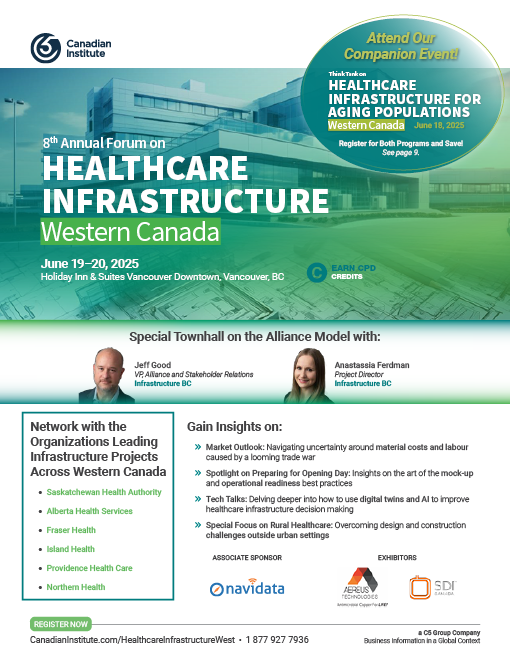Agenda

Flip through our conference brochure and discover what’s new this year.
Download Brochure
Day 1
June 19, 2025
Registration Opens and Breakfast is Served
Keynote
Market Analysis
Assessing Current Economic Conditions and the Potential Impact of a U.S.-Canada Trade War on Healthcare Infrastructure Project Costs

Ben ConnorDirectorBTY

Gareth DavidChief EstimatorPCL Construction

Vanessa WerdenPartnerJenkins Marzban Logan LLP

Sharat ChandraVice President, Strategic Capital Investments and FacilitiesFraser Health
Coming out of the pandemic, healthcare infrastructure projects faced three significant threats to on-time, on-budget delivery: supply chain disruptions, labor shortages, and material cost escalation. In the years since, B.C. and the rest of Canada have taken measures to bounce back and mitigate the impact, but a new shake-up to the market is looming—large tariffs.
This session panel discussion will offer insights on:
- Understanding the potential impact of U.S. tariffs and Canada’s retaliatory response on the cost and availability of aluminum, steel, technology, equipment, and other critical components for hospital construction
- Factoring tariffs and current economic conditions into project budgets and timelines
- Developing sourcing strategies—preparing to shift away from U.S. materials, labor, and expertise
- Assessing how the reduction of interprovincial trade barriers could support healthcare projects
- Identifying potential legal risks that could arise on projects and how to mitigate them
Morning Coffee Break

Jeff GoodVP, Alliance and Stakeholder RelationsInfrastructure BC

Anastassia FerdmanProject DirectorInfrastructure BC
The B.C. Alliance journey continues, with several major healthcare infrastructure projects now using this procurement model. Alliance models are designed to promote a more collaborative approach to project delivery through risk-sharing. This session will provide attendees with an opportunity to gather insights on how the model is working in practice.
Ample time will be left for the townhall portion of the panel. This is your opportunity to get your questions answered about the model, so that you can prepare for future projects.
Points of discussion will include:
- Examining why the Alliance Model is being used on major healthcare infrastructure projects in BC
- Identifying specific features of the Alliance Model that differ from prior models that were widely used for healthcare projects
- Anticipating how the Alliance Model will evolve based on recent project experiences
- Understanding Infrastructure BC’s role across all phases of the project
Networking Lunch
Healthcare Tech Talks
Smaller Group Discussions: How Are You Leveraging Emerging Technology in Healthcare Infrastructure Design, Construction and Operations?
Technology is changing by the day. It can be a challenge to vet cutting-edge technology, implement it, and remain poised to integrate what’s next.
This is an opportunity to continue the discussion about technology in smaller groups. Benchmark with peers around the table, pool insights, share stumbling blocks as well as recent success stories about how technology is being used to improve infrastructure planning or drive operational efficiencies. We will regroup, with one table representative sharing key takeaways from the discussion.
Afternoon Break
Navigating the Complexities of Equipment Planning: Tested Strategies and Innovative Tools that will Set Your Project Up for Success

Don BrentManager, Equipment PlanningNew St. Paul's Hospital, Providence Health Care

Chris WangPartnerNavidata

Maged AhmedDirector, Equipment PlanningOneEQ
Special Focus on Designing and Building in Rural Areas: Overcoming Challenges Associated with the Delivery of Healthcare Facilities Outside Urban Centres

Todd DustArchitect, PrincipalThinkSpace

Mary Ellen ReadArchitectNorthern Front Studio
Designing and building healthcare facilities in remote or rural locations presents unique challenges influenced by geography, climate, infrastructure, and local communities. Drawing from experiences on recent projects, this session will provide lessons learned on the importance of connecting with the community, planning carefully, and employing creative thinking to deliver these much-needed healthcare facilities.
Key points of discussion will include:
- Preparing for the impact of harsh weather from a design and construction perspective
- Anticipating logistical impacts on project delivery
- Designing infrastructure to withstand extreme conditions from heavy snowfall to seasonal flooding
- Recognizing how Indigenous and rural community needs differ from urban settings
- Developing creative solutions to address skilled labor shortages and a lack of existing infrastructure to support the build
- Supporting sustainability through passive design measures, material sourcing, and lifecycle analysis for operational gains
Day One Concludes
Day 2
June 20, 2025
Registration Opens and Breakfast is Served
Keynote & Conversation: Striving for Excellence in Cancer Care through the Built Environment
Future-Proofing Cancer Centres: Designing Facilities that are Equipped to Adapt to Innovation
Two in every five Canadians are expected to get a cancer diagnosis in their lifetime, according to the Canadian Cancer Society.* It’s a life altering event, that can be the start of a long and complex journey through treatment. Creating best-in-class care centres that remain on the cutting edge is imperative. This session will offer perspectives on how cancer treatment is evolving and how centres can are designed to provide the felibility needed to adapt to design.
- Understanding where advances are being made in cancer detection prevention and treatment
- Identifying the type of innovative tools and technology will transform cancer care and impact decisions around the built environment
- Exploring how to future-proof cancer centres in anticipation of innovation and new treatment options

Sunil KanamalaChief Project OfficerNorthern Health
Building a new, custom healthcare facility takes time and can come at a higher cost. For clinical staff who deliver care at multiple sites and for the patients who visit them, consistency matters. This has led B.C. and other provinces across the country to ask where we can further standardize hospital design so that delivery is more efficient—operating rooms, patient rooms?
Furthermore, how do we start to collaborate with industry to make this a reality? Panelists will share perspectives on what needs to happen to streamline healthcare design and construction, while also exploring where a more custom approach remains necessary. The discussion will pull in lessons learned from other sectors and jurisdictions.
Morning Coffee Break
Preparing for 'Day One'
Operational Readiness Revisited: Strategies for a Smooth Transition and Lessons Learned from Recent Activations

Anne ChisholmProject Transition CoordinatorKsyen Regional Hospital Terrace (Mills Memorial Replacement Project)

Anita WempeChief Clinical Planner, Burnaby Hospital RedevelopmentFraser Health

Jessica FosterSenior Leader, Strategic Change Management & Operational ReadinessFraser Health

Daniela MartinoClinical Planning Lead, Lions Gate HospitalVancouver Coastal Health

Alice GelpkeExecutive Director – CDH Replacement ProjectIsland Health
British Columbia has been busy building the future of healthcare. Several new hospitals are currently in flight, and many other major healthcare projects have now reached completion. It’s an important time to pool insights, share strategies, and apply lessons learned from recent activations so that future projects can build from strategies that proved successful and pivot where necessary for a smooth opening day.
This session will revisit an important conversation on operational readiness—an area that presents endless opportunities to improve the alignment of people and processes within the built environment. Panelists will provide insights on:
- Engaging clinical users during operational readiness planning
- Developing effective clinical workflows for the new facility
- Identifying potential pitfalls as you make the handoff to clinical staff
- Exploring opportunities to better support clinical staff during this period
- Sharing perspectives on strategies for a successful activation and candid conversations about areas for improvement

Tanya CampbellDirector, Project Delivery, Major Capital Projects, ClinicalNew St. Paul’s Hospital
- Determining what you want to achieve with the mock-ups
- Examining your goals—whether it’s mock-ups to test sightlines, design aesthetics, or large equipment
- Assessing how this will impact planning and budget
- Determining what parts of the new build are critical to mock-up because they will reduce the likelihood of numerous change orders later in the project
- Identifying pinch points in the design and troubleshooting based on the data collected
- Sharing lessons learned from the process
- Exploring how advanced technology like VR could assist with simulations and planning now and in the future
Lunch Break
Partnerships and Collaboration
Healthcare Infrastructure Community Engagement Strategies: How to Get Buy-in and Build Consensus
- Identifying who you should be engaging about a new healthcare infrastructure project in the community
- Developing a communication and engagement plan that meets the expectations of various groups within your community
- Pinpointing the right time to start the engagement process
- Exploring strategies for consensus-building
- Translating perspectives from various groups, including patients, caregivers, and Indigenous communities, into the built environment
- How to navigate the inclusion of what can present as competing and conflicting interests, values, and opinions
- Assessing what’s required from a budgeting and personnel perspective to not only carry out engagement but to implement the items identified as important to the community
Project Spotlight
A Holistic Approach to Healthcare Infrastructure: Connecting the Dots Between Sustainability, Evidence-Based Design and Inclusivity on the Cowichan District Hospital Replacement Project

Shane CzypyhaPrincipalParkin Architects Limited

Iain MacFadyenOwnerRGS Consultants

Meagan WebbRegional Leader - Vancouver, Associate Director Health, PrincipalH.H. Angus & Associates Ltd

Janeen KiddClinical Project DirectorCowichan District Hospital Replacement Project
Afternoon Coffee Break

Adriana EzelykManager, Infection Prevention & Control – Major Capital ProjectsIsland Health

Jessica FullertonRegional Infection Control Healthcare Facility Design Program Manager Planning & DevelopmentThe Ottawa Hospital
- Understanding current standards for material storage during construction
- Sharing pre-construction best practices for planning and budgeting for material storage
- Examining project specific examples of storage challenges and the risk mitigation measures that can be taken
- Factoring in climate and regional differences into decision-making about moisture susceptible materials

